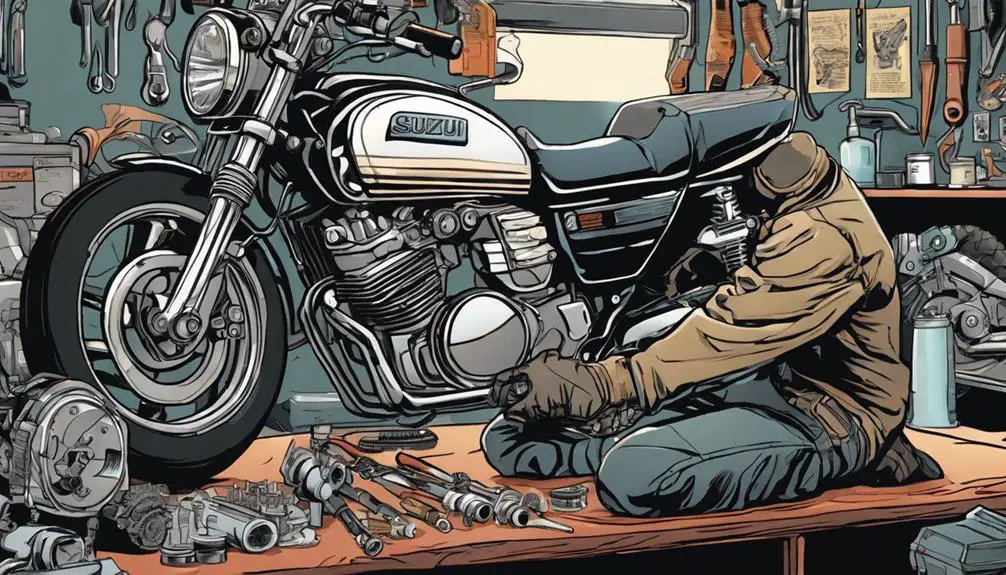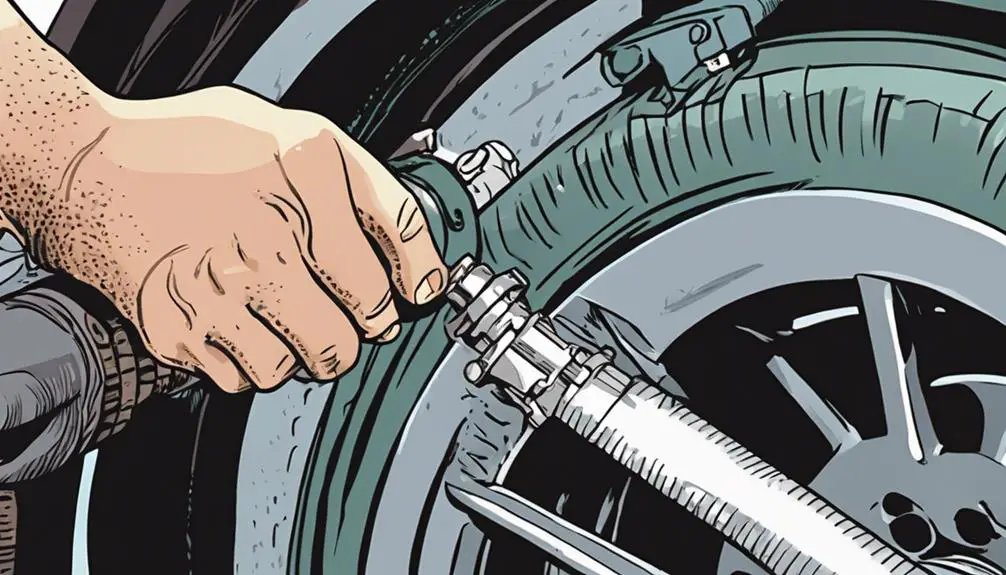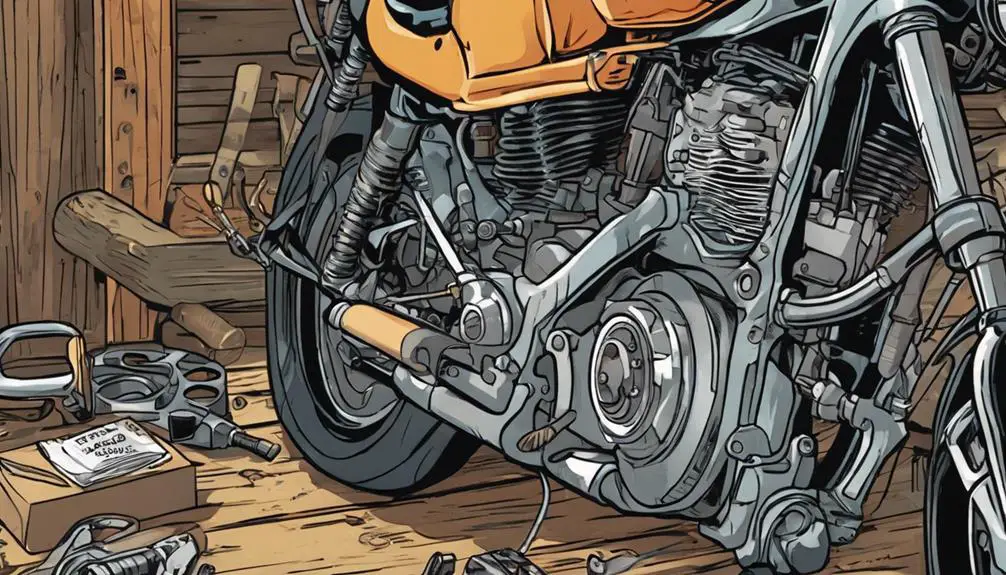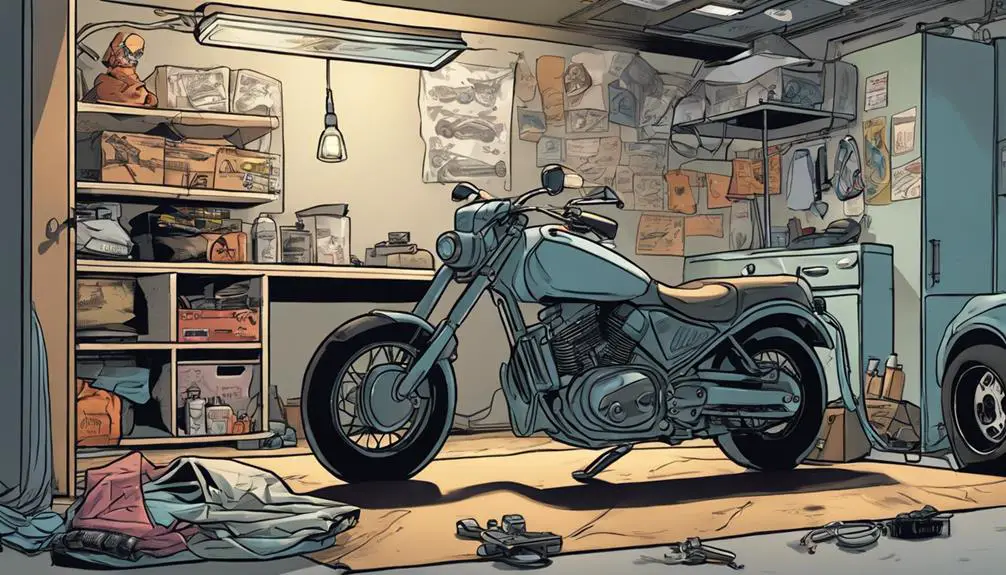As a beginner, you might not realize how essential proper motorcycle care is to your safety and enjoyment on the road. Regular oil changes can greatly enhance your engine's performance, while maintaining correct tire pressure can prevent potentially dangerous blowouts. You'll also want to keep an eye on your chain and brakes to make sure everything runs smoothly. But that's just scratching the surface—there are several key tips that can make a big difference in your motorcycle's longevity and reliability. Curious about what else you should be doing?
Quick Takeaways
- Regularly check and maintain oil levels to enhance engine performance and longevity.
- Keep tires properly inflated to improve grip, stability, and safety during rides.
- Lubricate the chain every 300-500 miles and inspect for wear to ensure smooth operation.
- Inspect brakes frequently for wear and functionality to ensure safe stopping power.
Understand Your Suzuki Motorcycle

To truly enjoy your ride, it's essential to familiarize yourself with the key features and specifications of your Suzuki motorcycle. Start by understanding the engine type, power output, and torque. Knowing these specs not only enhances your riding experience but also helps you harness the bike's full potential.
Next, get to know the braking system. Whether you're cruising through the city or hitting the open road, effective brakes are fundamental for safety and control. Familiarize yourself with the suspension settings too; they can dramatically influence how your bike handles different terrains.
Don't forget about the weight and balance of your Suzuki. A well-balanced bike feels more stable and responsive, empowering you to ride with confidence.
Lastly, explore your motorcycle's digital display and controls. Understanding indicators like fuel level, speed, and maintenance alerts can keep you informed and in control during your journey.
Regular Oil Changes
Knowing your Suzuki's specifications sets a solid foundation for understanding the importance of regular oil changes in maintaining your motorcycle's performance and longevity. Fresh oil lubricates your engine, reduces friction, and helps to prevent wear. It's essential for keeping your bike running smoothly and efficiently.
Here are some key reasons to prioritize oil changes:
- Performance Boost: Clean oil enhances engine performance, allowing for a more responsive ride.
- Longevity: Regular oil changes extend your engine's life, saving you money on repairs in the long run.
- Fuel Efficiency: Fresh oil improves fuel efficiency, letting you ride longer without stopping for gas.
As a rider, you want every journey to be exhilarating and trouble-free. By committing to regular oil changes, you're investing in your freedom on the road.
Keep track of your oil change intervals and enjoy the liberation that comes with a well-maintained motorcycle. Remember, your bike's performance is directly tied to its oil—don't overlook this simple yet crucial task!
Check Tire Pressure

Checking your tire pressure is essential for your safety and bike performance.
You can easily measure it with a gauge, and knowing the right pressure helps prevent issues on the road.
Let's explore why proper tire pressure matters and how to keep your tires in top shape.
Importance of Proper Pressure
Maintaining the right tire pressure is essential for your motorcycle's performance and safety on the road. When your tires are properly inflated, they grip the road better, which enhances your control and stability. You'll experience a smoother ride and improved fuel efficiency, allowing you to wander freely without constantly worrying about your bike's performance.
Here are some key benefits of keeping an eye on your tire pressure:
- Enhanced Safety: Properly inflated tires reduce the risk of blowouts and improve handling during critical maneuvers.
- Improved Fuel Efficiency: Correct pressure helps your engine run more efficiently, saving you money on gas and letting you ride longer.
- Longer Tire Life: Maintaining tire pressure can prolong the lifespan of your tires, giving you more miles to explore the open road.
How to Measure
To guarantee your motorcycle tires are properly inflated, you'll need a reliable tire pressure gauge, which makes the measuring process quick and easy.
Start by checking the pressure when your tires are cold, ideally before you ride. This assures accurate readings since heat from riding can increase tire pressure.
First, remove the valve cap from the tire you want to check. Press the tire pressure gauge onto the valve stem firmly. You'll hear a hissing sound initially, but don't worry; that's just air escaping. Read the pressure displayed on the gauge. If you're using a digital gauge, it'll show you the pressure instantly.
Repeat this process for both front and rear tires. Make sure to note the readings to compare later. If you notice any significant discrepancies, don't hesitate to recheck. Keeping your tires at the right pressure isn't just about performance; it also enhances your safety and riding experience.
With practice, you'll become more confident in measuring tire pressure. So grab that gauge, take control, and confirm your ride is as liberating as the open road itself!
Tire Pressure Recommendations
Your motorcycle's performance and safety hinge on adhering to the recommended tire pressure levels specified in the owner's manual or on the tire sidewall.
Keeping your tires properly inflated not only enhances your ride but also boosts fuel efficiency and prolongs tire life.
Here are some essential tips for checking and maintaining tire pressure:
- Check Regularly: Inspect your tire pressure at least once a month and before long rides.
- Use a Reliable Gauge: Invest in a quality tire pressure gauge for accurate readings.
- Adjust When Cold: Measure tire pressure when the tires are cold, preferably before riding or after resting for a few hours.
Maintain the Chain
Maintaining your motorcycle chain is essential for a smooth ride and longevity.
You'll need to lubricate it regularly, check for wear, and adjust the tension to keep everything running efficiently.
Ignoring these steps can lead to bigger problems down the road, so let's get into the details.
Chain Lubrication Frequency
Regularly lubricating your motorcycle chain guarantees smooth operation and extends its lifespan. Neglecting this essential maintenance can lead to unnecessary wear and tear, leaving you stranded on the open road.
To keep your chain in top shape, consider the following frequency guidelines:
- After every ride in wet conditions: Rain and mud can wash away lubrication, so don't skip this step.
- Every 300-500 miles: This interval is a good rule of thumb for regular riders. Adjust based on your riding style and environment.
- Before long trips: If you're planning a journey, make sure to give your chain some love beforehand.
Inspect for Wear
It's important to inspect the chain for wear, as even minor damage can lead to bigger problems down the road. Start by visually examining the chain for any signs of stretching or kinks. A chain that looks uneven or has tight links may not function properly and can cause your bike to handle poorly.
Next, check for rust or corrosion, which can weaken the chain and affect its performance. If you spot these issues, consider replacing the chain sooner rather than later.
Pay attention to the sprockets as well. Worn sprockets can damage a healthy chain, leading to a costly cycle of repairs. Look for hooked or uneven teeth on the sprockets; if they're not uniform, it's time to address the issue.
Lastly, don't forget to feel the chain while you inspect it. Run your fingers along the length to detect any rough spots or stiffness. A well-maintained chain is vital for a smooth ride and keeping you in control on the open road.
Proper Tension Adjustment
Adjusting your chain's tension is essential for ideal performance and safety on your motorcycle. A properly tensioned chain guarantees smooth operation, prolongs the life of your components, and enhances your riding experience.
Neglecting this aspect can lead to chain wear, poor handling, or even accidents. Here's how to maintain that liberating ride:
- Check tension regularly: Make it a habit to inspect your chain tension before each ride or at least once a week.
- Use the correct tools: You'll need a wrench and a chain tool to make adjustments easily.
- Follow the manufacturer's guidelines: Refer to your owner's manual for the specific tension range for your bike.
Inspect Brakes Frequently

Make it a habit to inspect your brakes frequently, as they're vital for your safety on the road. Your brakes are your lifeline, and you want to guarantee they're in top shape.
Start by checking the brake fluid level; low fluid can indicate a leak or worn components. If you notice any fluid loss, don't hesitate to dig deeper.
Next, examine the brake pads for wear. If they're worn down to about a quarter of an inch, it's time to replace them. Listen for any unusual noises when you brake—squealing or grinding can signal that your pads are shot.
Also, take a look at your brake discs. They should be smooth and free from deep grooves. If you see any issues, it's imperative to address them immediately.
Clean Your Motorcycle
Regular cleaning not only enhances your motorcycle's appearance but also helps maintain its performance and longevity.
When you take the time to clean your ride, you're not just polishing metal; you're guaranteeing that every component functions smoothly. The freedom of the open road deserves a machine that's in top shape, and a clean bike is a happy bike.
Here are some essential cleaning tips to keep your motorcycle thriving:
- Use the Right Products: Choose motorcycle-specific cleaners to avoid damaging surfaces.
- Focus on the Chain: Clean and lubricate your chain regularly to guarantee smooth shifting and longevity.
- Don't Forget the Wheels: Brake dust and grime can build up; clean your wheels to maintain performance and grip.
Store Properly During Off-Season

Proper off-season storage is essential for keeping your motorcycle in peak condition and ready for the next ride. When the colder months roll in, it's time to take a few steps to guarantee your bike stays healthy.
Start by finding a dry, clean space where your motorcycle can rest. A garage is great, but if that's not an option, a quality motorcycle cover will work wonders against the elements.
Next, make sure to top off your fuel tank and add a fuel stabilizer. This prevents the fuel from breaking down and causing issues later. Don't forget to change the oil and filter before storing; it's a simple way to protect your engine.
Check the tire pressure and inflate them to the recommended levels. You might even consider placing your bike on a stand to prevent flat spots.
Common Questions
What Tools Do I Need for Basic Motorcycle Maintenance?
For basic motorcycle maintenance, you need a few essential tools.
Start with a good set of wrenches and sockets to tackle bolts and nuts.
A screwdriver set is vital for various adjustments.
Don't forget a tire gauge and a pump to keep your tires in shape.
A chain cleaner and lubricant will help maintain your bike's performance.
Finally, have a torque wrench handy to guarantee everything's tightened just right.
You're ready to ride!
How Often Should I Wash My Motorcycle?
You should wash your motorcycle every two to four weeks, depending on how often you ride and the conditions you encounter.
If you're cruising through muddy trails or facing salty roads, clean it more often.
Regular washes not only keep your ride looking sharp but also help prevent rust and corrosion.
Just remember to use gentle soap and avoid high-pressure washers, as they can damage sensitive parts.
Keep your bike shining and protected!
Can I Use Car Oil in My Motorcycle?
You might be tempted to use car oil in your motorcycle, but it's not a good idea.
Motorcycle engines operate at different temperatures and pressures, requiring specific oil formulations. Car oil can lack the necessary additives for wet clutches and high-performance demands.
Stick with motorcycle-specific oil to guarantee your ride runs smoothly and efficiently. Protect your investment by choosing the right oil; your bike will thank you with better performance and longevity.
How Do I Know if My Battery Needs Replacement?
Did you know nearly 30% of motorcycle breakdowns are due to battery issues?
To know if your battery needs replacement, check for signs like dim headlights, slow engine cranking, or corrosion around the terminals.
You can also test the voltage with a multimeter; anything below 12.4 volts often means it's time for a new battery.
Don't let a weak battery hold you back from the freedom of the road—stay proactive!
What Should I Do if My Motorcycle Won't Start?
When your motorcycle won't start, don't panic.
First, check the battery connections; they might be loose or corroded. If you hear clicking sounds, the battery could be weak. Try jump-starting it with another bike.
If that doesn't work, inspect the fuel level and make sure you're not on reserve.
Wrapping Up
By following these seven essential motorcycle care tips, you're not just ensuring your bike runs smoothly; you're also forging a deeper connection with your ride.
Every oil change, tire check, and chain lubrication becomes a moment of mindfulness, blending the thrill of the journey with the responsibility of ownership.
As you clean and store your motorcycle properly, you'll find that these small acts of care lead to big rewards—enhanced performance and countless adventures await you on the open road.